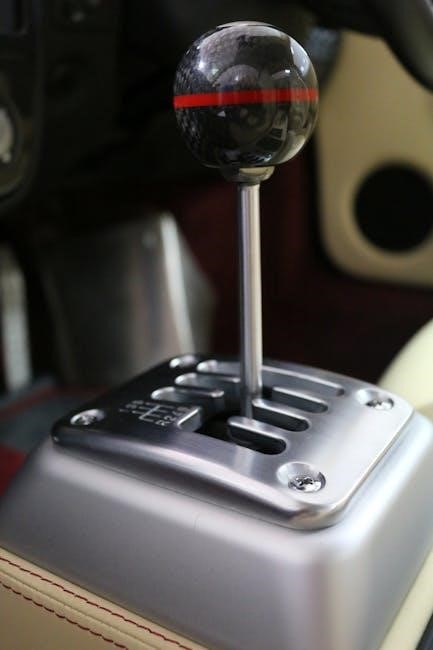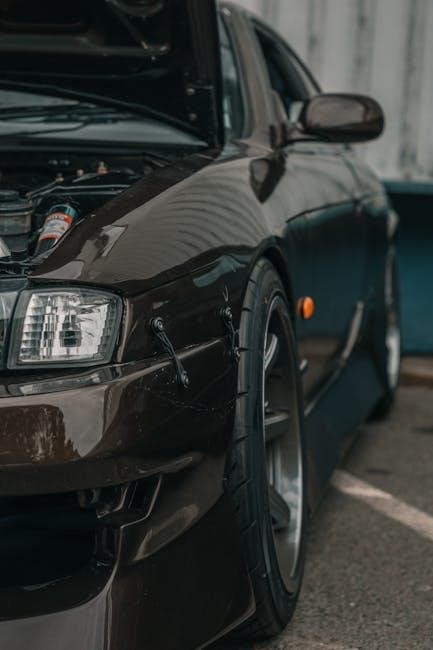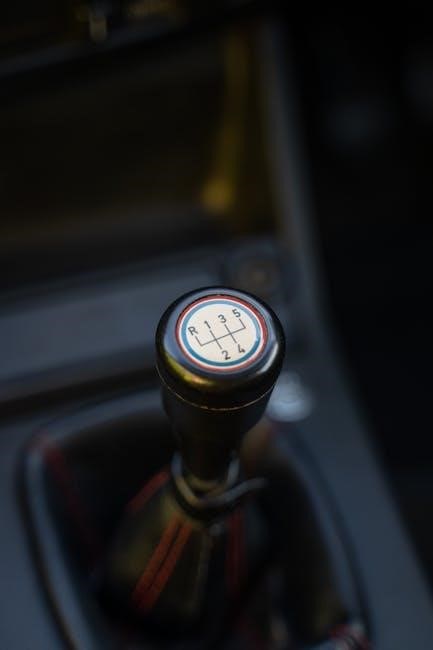The 1UZ-FE engine, a 4.0L V8 powerhouse, is popular for swaps, but its stock automatic transmission often limits performance. Converting to a manual transmission enhances control, power delivery, and driving experience, making it a sought-after modification. This guide explores the process, benefits, and challenges of installing a manual transmission on the 1UZ-FE, helping enthusiasts achieve better connectivity between driver and engine.
1.1 What is the 1UZ-FE Engine?
The 1UZ-FE is a 4.0L V8 engine produced by Toyota, known for its aluminum construction, dual overhead camshafts, and 4 valves per cylinder. It powers various Toyota and Lexus models, delivering smooth performance and reliability. With a reputation for durability and versatility, the 1UZ-FE has become a popular choice for engine swaps, offering a balance of power and efficiency that makes it ideal for both stock applications and high-performance builds.
1.2 Why Consider a Manual Transmission for the 1UZ-FE?
Considering a manual transmission for the 1UZ-FE enhances driving engagement and control, offering a more connected experience. It typically improves fuel efficiency and acceleration, with lower maintenance costs. Manual transmissions are cost-effective and preferred by enthusiasts for their precision and performance. However, they require more skill and effort, which may not suit all drivers. The swap aligns with those seeking a more interactive and efficient driving experience, balancing performance and practicality.
1.3 Overview of the Manual Transmission Conversion Process
Converting the 1UZ-FE to a manual transmission involves several key steps, including selecting a compatible transmission, fabricating an adapter plate, and installing a clutch system. Wiring modifications are necessary to adapt the ECU for manual operation, and engine mounts may need customization. The process requires careful planning, mechanical expertise, and attention to detail. While challenging, the conversion offers significant rewards for enthusiasts seeking enhanced performance and driver engagement.

Feasibility and Benefits of Manual Transmission Conversion
Converting the 1UZ-FE to a manual transmission is feasible with the right components and expertise. It offers improved performance, driver engagement, and potential fuel efficiency gains, making it a rewarding upgrade for enthusiasts.
2.1 Is a Manual Transmission Suitable for the 1UZ-FE?
A manual transmission is highly suitable for the 1UZ-FE engine, offering enhanced performance and control. The engine’s robust torque output makes it compatible with various manual transmissions like the W58 or R154, commonly used in high-performance applications. Proper installation and component selection ensure reliability and seamless integration, catering to both street driving and racing scenarios.
2.2 Benefits of a Manual Transmission Over an Automatic
A manual transmission offers superior performance, driver engagement, and fuel efficiency compared to an automatic. It provides precise control over gear shifts, enhancing acceleration and responsiveness. Manual transmissions are also lighter, more durable, and require less maintenance. For the 1UZ-FE, a manual setup allows better utilization of the engine’s torque, delivering a more connected driving experience, whether for daily driving or high-performance applications, making it a preferred choice for enthusiasts seeking optimal power delivery and control.
2.3 Potential Drawbacks and Challenges
Converting the 1UZ-FE to a manual transmission involves significant complexity and cost. Custom components like adapter plates and flywheels are often required, and wiring modifications are necessary to ensure proper ECU communication. Additionally, the shifter and linkage system must be precisely installed, and compatibility issues with aftermarket parts can arise. The process demands specialized tools and expertise, making it a challenging project for inexperienced enthusiasts. These factors contribute to the overall difficulty and expense of the conversion, requiring careful planning and execution.
Choosing the Right Manual Transmission
Selecting the right manual transmission for the 1UZ-FE involves considering compatibility, power output, and build goals; The W58 and R154 are popular choices, with the W58 suitable for lower power applications and the R154 handling higher power. Custom adapter plates and flywheels are often required for proper mating, ensuring a seamless connection between the engine and transmission. This step is crucial for achieving optimal performance and reliability in the conversion.
3.1 Compatible Manual Transmissions for the 1UZ-FE
Popular manual transmissions for the 1UZ-FE include the Toyota W58 and R154, both known for durability and compatibility. The W58 is ideal for lower-power builds, while the R154 handles higher power. Other options like the Toyota T50 or Volvo AW71 can also be adapted with custom modifications. Each transmission requires specific adapter plates and flywheel setups to mate with the 1UZ-FE. These transmissions are widely discussed in forums and are preferred for their reliability and performance in such conversions.
3.2 W58 vs. R154: Which is Better for Your Build?
The W58 and R154 are both strong candidates for the 1UZ-FE; The W58 is lighter and simpler, ideal for street driving and builds under 400 horsepower. It features a shorter gear ratio, enhancing acceleration. The R154, while heavier, is more robust and handles higher torque, making it better for performance-oriented builds. Gear ratios in the R154 are longer, offering smoother highway performance. Choose based on your power goals and driving style to optimize performance and reliability in your manual setup.
3.3 Other Transmission Options and Their Compatibility
Beyond the W58 and R154, enthusiasts explore other transmissions like the T56 and V160 for their strength and compatibility. The T56 is favored for high-horsepower builds due to its robust design, while the V160 offers precise shifting in racing setups. Volvo’s AW71/72/73 transmissions are also considered for their durability and smooth operation. Each option requires careful research into compatibility, adapter plates, and custom fabrication to ensure proper integration with the 1UZ-FE engine, making the choice highly build-specific.

Clutch System and Flywheel
A compatible clutch system and flywheel are essential for smooth manual transmission operation. The stock clutch from the W-59 often suffices, but aftermarket options provide improved durability. Custom flywheels may be required for proper fitment, ensuring efficient power transfer and avoiding potential issues during installation.
4.1 Selecting the Right Clutch for Your Manual Transmission
Selecting the right clutch for your 1UZ-FE manual transmission is crucial for optimal performance. While the stock clutch from the W-59 often suffices, aftermarket options are recommended for enhanced durability and better power transfer. These clutches are designed to handle increased torque and provide smoother engagement, which is especially beneficial for high-performance applications. Additionally, consider a custom flywheel if your setup requires it, ensuring proper fitment and efficient energy transfer from the engine to the transmission.
4.2 Flywheel Options: Stock vs. Aftermarket
The stock flywheel on the 1UZ-FE is compatible with manual transmissions like the W58 but may require resurfacing for optimal performance. Aftermarket flywheels are available, offering lightweight designs that reduce rotational mass and improve acceleration. These options are ideal for high-performance builds, ensuring better heat dissipation and smoother clutch engagement. When choosing, consider your power goals and driving style to select the most suitable flywheel for your manual transmission setup.
4.3 Installation Tips for the Clutch and Flywheel
Proper installation of the clutch and flywheel is crucial for smooth operation. Ensure the flywheel is resurfaced or replaced if worn, and align the clutch disc correctly using the pilot bearing. Use a clutch alignment tool to center the disc. Tighten the pressure plate evenly in a star pattern to avoid warping. Check compatibility between the clutch and flywheel to prevent improper fitment. Follow manufacturer instructions for torque specs and lubrication. Proper installation ensures optimal performance and prevents premature wear.

Transmission Adapter Plate and Mounts
A custom or pre-made adapter plate is essential for connecting the manual transmission to the 1UZ-FE engine, ensuring proper alignment and fitment. Engine mounts are crucial for stability and smooth operation, reducing vibration and preventing damage to the transmission and engine. Properly fitted mounts and a well-designed adapter plate ensure a seamless integration of the manual transmission system.
5.1 The Importance of a Transmission Adapter Plate
The transmission adapter plate is crucial for aligning the manual transmission with the 1UZ-FE engine, ensuring proper fitment and functionality. It acts as a bridge, securely mating the engine and transmission, while preventing vibration and stress on connected components. A well-designed adapter plate is essential for maintaining engine performance and transmission longevity. Typically custom-made, it ensures compatibility and proper gear engagement, making it a vital component for a smooth manual transmission swap.
5.2 Custom vs. Pre-Made Adapter Plates
Choosing between custom and pre-made adapter plates depends on specific needs and budget. Custom plates offer precise fitment tailored to the 1UZ-FE and chosen transmission, often required for unique setups. Pre-made plates are cost-effective and readily available for common configurations like the W58 or R154. Both options ensure proper alignment and durability, but custom plates provide superior adaptability for specialized builds, making them ideal for enthusiasts seeking a seamless manual transmission integration.
5.3 Engine and Transmission Mounts for a Smooth Connection
Engine and transmission mounts are crucial for a smooth, vibration-free connection. Custom mounts are often necessary for manual setups, ensuring proper alignment and support. Stock mounts may not suffice, as they are designed for automatic transmissions. Upgrading to durable, high-quality mounts enhances drivetrain stability and reduces wear. Properly fitted mounts also improve throttle response and minimize vibrations, making the driving experience more enjoyable and reliable. They play a key role in maintaining optimal performance and longevity of the manual transmission system.

Wiring and ECU Considerations
Modifying the wiring harness is essential, removing automatic transmission-related wires and adding a manual transmission loom. The ECU must be reconfigured to recognize the manual setup properly.
6.1 Understanding the ECU’s Role in Manual Transmission
The ECU plays a critical role in managing the 1UZ-FE engine, particularly when switching to a manual transmission. It must recognize the absence of automatic components and adapt engine control parameters. Sensors for torque and gear position are vital for smooth operation. Without proper ECU configuration, the engine may not function optimally, leading to issues like poor acceleration or fuel efficiency. Thus, reprogramming or using a standalone ECU is often necessary to ensure compatibility and performance.
6.2 Wiring Modifications for Manual Transmission
Wiring modifications are essential when converting the 1UZ-FE to a manual transmission. The stock wiring harness includes circuits for automatic transmission controls, which must be removed or repurposed. Key steps include identifying and disabling automatic-specific sensors and solenoids, while integrating wiring for manual components like the clutch switch and gear position sensor. A clean, simplified wiring setup ensures proper communication between the ECU and manual transmission, avoiding potential electrical conflicts. Forums and specialists often provide detailed diagrams to guide this process.
6.3 Can You Use the Stock ECU with a Manual Transmission?
The stock ECU from the automatic transmission-equipped 1UZ-FE can be adapted for manual use, but it requires modifications. By bypassing or reprogramming certain signals, such as the neutral/park switch, the ECU can function with a manual setup. However, achieving optimal performance may necessitate a standalone ECU or custom tuning. Some enthusiasts have successfully used the stock ECU with minimal adjustments, while others prefer a dedicated manual-specific ECU for better control and reliability. Consultation with specialists is highly recommended for this process.

Shifter and Linkage Installation
Installing a shifter and linkage for the 1UZ-FE manual conversion requires precise alignment and custom mounts to ensure smooth gear engagement. Proper setup is crucial for optimal performance.
7.1 Choosing the Right Shifter for Your Setup
Selecting the appropriate shifter for your 1UZ-FE manual conversion involves considering compatibility with your transmission type, such as the W58 or R154, and ensuring proper fitment in your vehicle. The shifter must align with the transmission’s gear lever and match the drivetrain layout. Popular options include aftermarket shifters designed for the 1UZ-FE, offering improved ergonomics and durability. Additionally, the shifter’s throw length and shift feel should align with your driving preferences. Consulting with specialists or forums can provide tailored recommendations for your specific setup.
7.2 Installing the Shifter and Linkage System
Installation of the shifter and linkage requires precise alignment with the transmission’s gear lever. Ensure the shifter is securely mounted to the floor or tunnel, maintaining proper geometry for smooth shifting. The linkage must be adjusted to eliminate any play or binding, ensuring accurate gear engagement. Proper installation involves measuring and potentially modifying the shift lever to fit your vehicle’s layout. Detailed alignment and adjustment are crucial for optimal performance and driver control, often necessitating specialized tools or professional expertise for precise setup.
7.3 Adjusting the Shifter for Optimal Performance
Proper shifter adjustment ensures precise gear engagement and smooth operation. Align the shifter with the transmission’s gear lever, ensuring no misalignment. Adjust the linkage tension to eliminate play or binding, as excessive looseness can lead to missed shifts. Fine-tune the shifter’s position for ergonomic comfort, allowing easy access to all gears. Test the shifter through all gears to confirm smooth engagement and disengage. Proper adjustment enhances driving experience and prevents premature wear on components, ensuring reliable performance over time.

Engine Mounts and Crossmember
Engine mounts secure the 1UZ-FE, absorbing vibrations and preventing movement. The crossmember may need modification to fit the manual transmission, ensuring proper clearance and support for optimal performance and stability.
8.1 The Importance of Engine Mounts in a Manual Setup
Engine mounts are crucial in a manual setup for the 1UZ-FE, ensuring stability and reducing vibrations. They prevent engine movement during shifting, maintaining proper alignment with the transmission. Custom mounts are often necessary to accommodate the manual setup, offering improved durability and performance. Properly installed mounts enhance drivetrain efficiency and minimize wear on components, making them essential for a smooth and reliable manual transmission conversion.
8.2 Custom Engine Mounts for the 1UZ-FE
Custom engine mounts are essential for a manual transmission setup, as they provide the necessary stability and durability. The 1UZ-FE engine, originally designed for automatic transmissions, requires sturdier mounts to handle the increased stress of manual shifting. Polyurethane or billet aluminum mounts are popular choices, offering better vibration damping and resistance to wear. Improper mounts can lead to drivetrain misalignment and premature component failure, making custom mounts a critical investment for a reliable conversion.
8.3 Crossmember Modifications for Transmission Clearance
Modifying the crossmember is often necessary to accommodate the manual transmission’s larger footprint and ensure proper drivetrain alignment. The stock crossmember, designed for the automatic transmission, may not provide sufficient clearance or support. Fabricating or sourcing a custom crossmember ensures the transmission sits correctly, maintaining proper geometry and preventing vibration issues. This step is crucial for a seamless conversion, as it directly impacts the transmission’s stability and the vehicle’s overall performance.

Testing and Tuning
After installation, thorough testing ensures the manual transmission operates smoothly. Initial drives focus on clutch engagement, gear shifts, and synchro performance. Fine-tuning the ECU for manual operation optimizes power delivery and responsiveness, addressing potential issues like hesitation or incorrect gear behavior. Continuous monitoring and adjustments are essential to achieve seamless functionality and maximize performance.
9.1 Initial Testing of the Manual Transmission Setup
Initial testing of the manual transmission setup involves starting with the car in park or neutral, ensuring the clutch and gear shifts function smoothly. Test low-speed maneuvers to check for proper engagement and disengagement of gears. Monitor for any unusual noises or vibrations, which could indicate misalignment or component issues. Pay attention to the clutch pedal feel and ensure it doesn’t slip or grab unexpectedly. This step is crucial for identifying any installation errors before proceeding to higher-speed testing or tuning.
9.2 Tuning the ECU for Optimal Performance
Tuning the ECU is essential for optimizing performance with a manual transmission. Adjustments to fuel injection, ignition timing, and torque parameters ensure smooth operation and maximize power delivery. The stock ECU may require modifications or a standalone unit for precise control. Reflash or remap the ECU to accommodate the manual setup, focusing on throttle response and gear shifts. A custom tune can enhance drivability and performance, making the most of the 1UZ-FE’s capabilities in a manual configuration.
9.3 Common Issues to Watch Out For
Common issues during a manual transmission conversion include improper clutch alignment, ECU communication errors, and wiring faults. Misaligned sensors or incorrect adapter plates can cause gear engagement problems. Additionally, insufficient engine support during installation may lead to mechanical wear. Addressing these issues early ensures a smooth transition and prevents long-term damage. Proper installation and thorough testing are crucial to avoid these pitfalls and achieve a reliable manual setup for the 1UZ-FE engine.

Legal and Insurance Considerations
Ensure compliance with local vehicle regulations and obtain necessary approvals for the manual transmission swap. Notify your insurance provider to maintain coverage and avoid policy issues.
10.1 Legal Requirements for Engine and Transmission Swaps
Ensure your manual transmission swap complies with local vehicle codes and emissions standards. Obtain necessary approvals from authorities for engine and transmission modifications. Verify if your swap requires inspections or certifications. Documentation, such as proof of parts compatibility and installation, may be mandatory. Consulting with local regulatory agencies is crucial to avoid legal issues. Always check if your vehicle’s title and registration need updates post-swap. Compliance ensures safety and avoids penalties. Proper documentation is key for smooth inspections and legal validation.
10.2 Insurance Implications of a Manual Transmission Conversion
Notify your insurance provider about the manual transmission conversion, as it may affect your policy. Modified vehicles often require specialized coverage, and failure to disclose changes could void your insurance. Expect potential increases in premiums due to the altered vehicle configuration. Some insurers offer policies tailored for modified or high-performance vehicles, so it’s wise to explore options. Always verify that your policy covers the vehicle post-conversion to maintain legal and financial protection.
10.3 Documentation and Compliance
Ensure all modifications comply with local regulations and that the vehicle passes inspections. Maintain detailed records of the conversion, including receipts and engineering reports. A roadworthy certificate may be required post-conversion. Failure to comply could result in fines or registration denial. Consult local authorities to confirm specific requirements. Proper documentation ensures legality and avoids potential issues. Always verify that your conversion meets safety and emissions standards to maintain compliance and avoid legal complications.

Community and Resources
Engage with forums and communities for support and advice on manual transmission conversions. Specialists like CRS offer complete kits and expertise, while DIY resources are also available.
11.1 Forums and Communities for Support
Forums and communities are invaluable for manual transmission conversions. Websites like Reddit, Facebook groups, and specialized automotive forums offer extensive discussions and guides. Members share experiences, troubleshooting tips, and recommendations. Social media groups dedicated to Toyota and Lexus enthusiasts provide real-time support. These platforms are essential for connecting with experts and enthusiasts who have completed similar projects. Engaging with these communities can save time and help overcome challenges during the conversion process.
11.2 Recommended Specialists for the Conversion
Specialists like CRS offer comprehensive kits for 1UZ-FE manual conversions, including flywheels, bellhousings, and clutches. They also provide rebuilt W58 transmissions tailored to your build. Additionally, experts in custom wiring and transmission setups can be found through forums and community recommendations. These specialists ensure compatibility and optimal performance, making the conversion process smoother and more reliable. Their expertise is crucial for achieving a seamless integration of manual transmission with the 1UZ-FE engine.
11.3 DIY vs. Professional Installation: Pros and Cons
A DIY manual transmission conversion can save costs and provide a sense of accomplishment but requires extensive mechanical knowledge and time. Professional installation ensures expertise, safety, and reliability but adds labor costs. DIY is ideal for experienced enthusiasts, while professionals are recommended for complex or high-performance builds. Weighing skills, budget, and desired outcomes is crucial for deciding the best approach for your 1UZ-FE manual transmission project.
Converting the 1UZ-FE to a manual transmission offers a rewarding driving experience with enhanced control and performance. While challenging, the satisfaction of a successful swap is unmatched.
12.1 Final Thoughts on the Manual Transmission Conversion
Converting the 1UZ-FE to a manual transmission is a rewarding yet challenging endeavor. It requires meticulous planning, research, and often custom solutions. The satisfaction of achieving a smooth, driver-connected experience makes the effort worthwhile. Enthusiasts should weigh their goals, budget, and mechanical aptitude before starting. Proper planning and execution are crucial for success. The 1UZ-FE’s potential shines brightest with a manual setup, offering unparalleled control and performance for dedicated drivers.
12.2 Encouragement for Those Considering the Swap
Embarking on a manual transmission conversion for the 1UZ-FE is a bold move, but it’s incredibly rewarding for enthusiasts seeking enhanced control and performance. While challenges exist, the sense of accomplishment and improved driving experience make it worthwhile. Don’t hesitate to seek guidance from forums, specialists, and experienced builders. With dedication and the right resources, you can successfully achieve a setup that unlocks your engine’s full potential and delivers the driving experience you’ve always desired.
